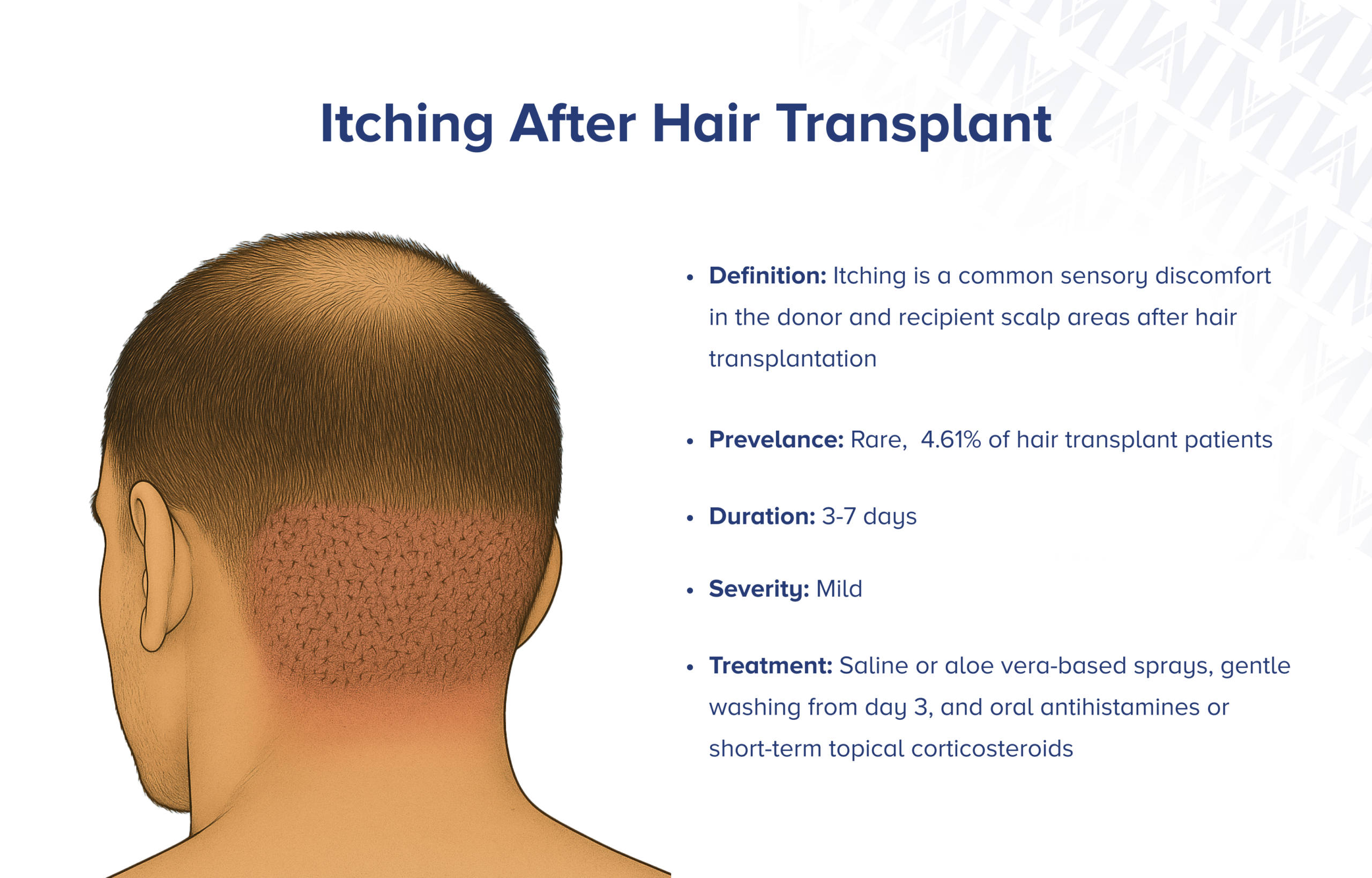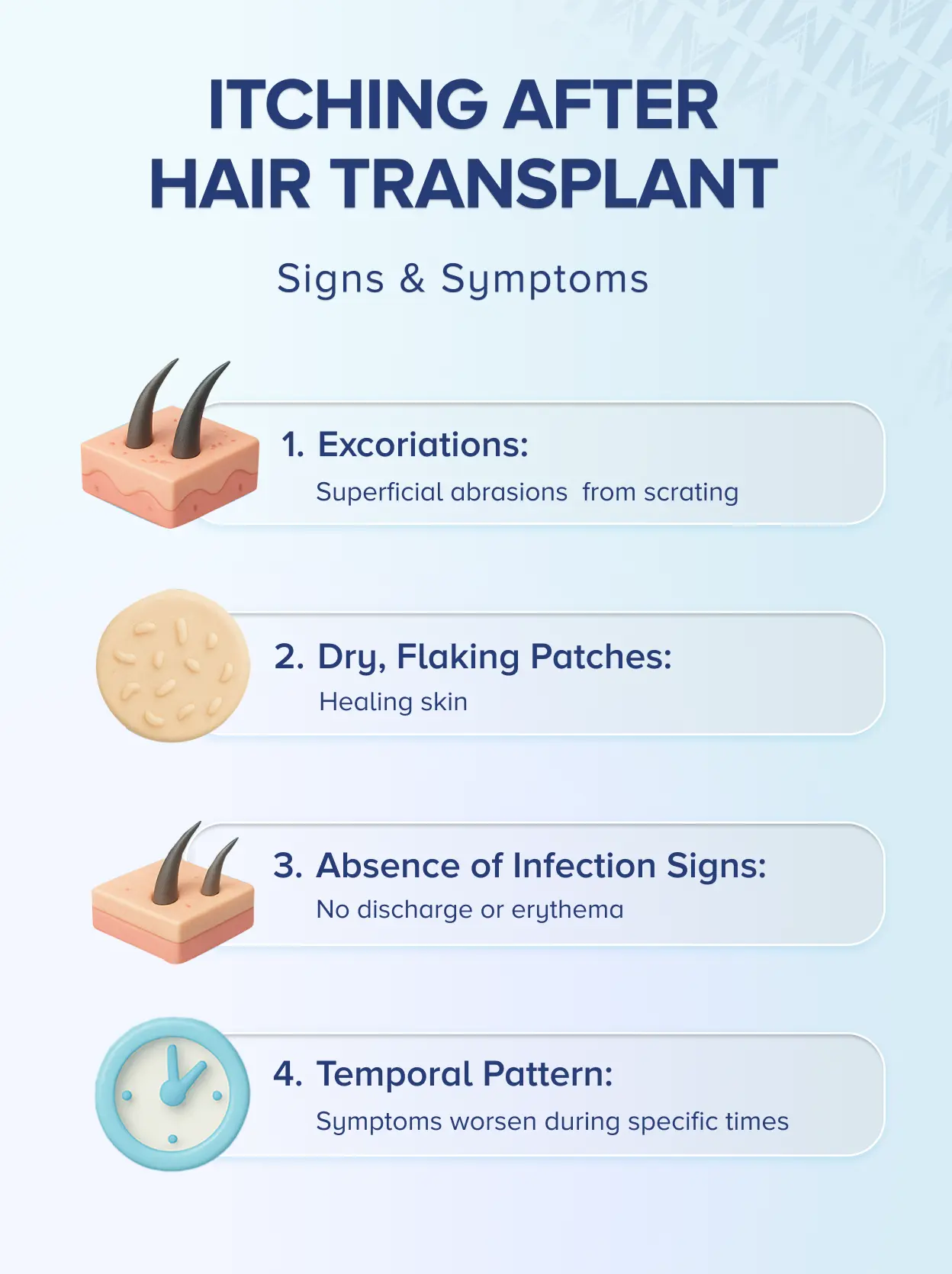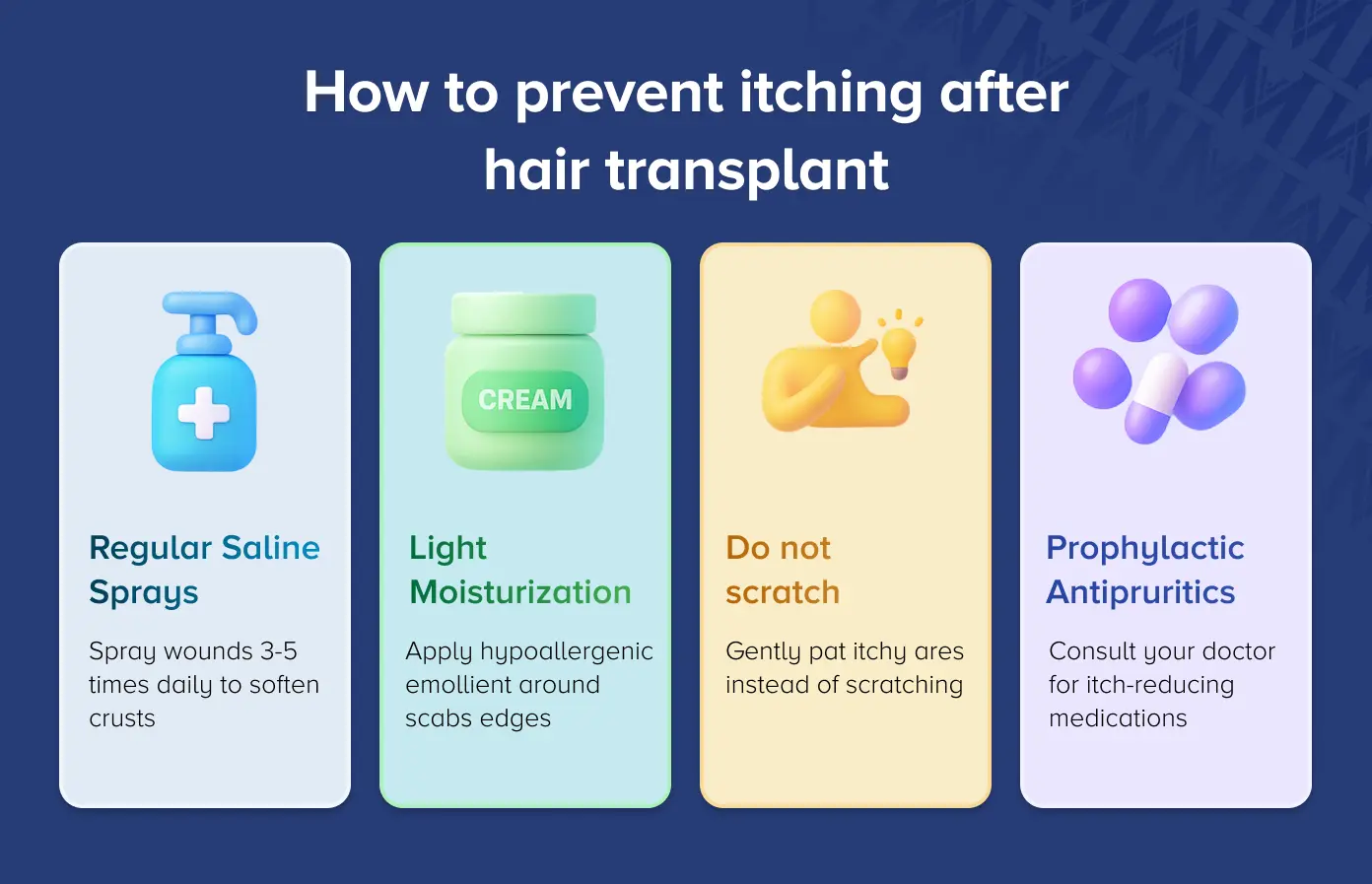Itching after a hair transplant (scalp pruritus) is a skin reaction triggered by the activation of specific nerve fibers in both the donor and recipient areas after follicular unit extraction (FUE) or strip harvesting (FUT). Hair transplant itching is typically linked to scab formation and inflammation, which activate itch receptors.
Although generally mild and self‐limited, itching after hair transplantation can cause significant discomfort during the early healing phase and, if severe, may lead to complications such as graft dislodgement or infection. Since approximately 4.61% of hair‐transplant patients report itching two months after surgery, understanding its onset, risk factors, prevention strategies, and management is vital to ensure optimal outcomes and patient satisfaction after hair transplant surgery.
Key Points
- Hair transplant itching is caused by scab formation and inflammatory mediators activating itch receptors.
- Around 4.61% of patients experience itching at two months post-hair transplant.
- Itching typically begins around days 3-5 postoperatively and resolves by two weeks with proper care.
- Drying, crusting, and delayed gentle washing increase risk of developing pruritus.
- Diagnosis is clinical, based on localized scalp pruritus and exam findings of crusts or excoriations.
- Mild itching is self-limited; severe scratching can disrupt grafts and elevate infection risk.
- Prevention includes saline sprays, early gentle washing, and light moisturization.
- Treatment options include saline or aloe vera sprays, oral antihistamines, and short-term topical corticosteroids.
- Itching usually resolves as crusts shed and the scalp re-epithelializes within one to two weeks.
- Seek medical attention if itching persists beyond 2 weeks or is accompanied by signs of infection.
What is itching after a hair transplant?
Hair transplant itching (pruritus) is an unpleasant sensory experience provoking an urge to scratch the donor and recipient areas of the scalp after hair restoration surgery as the wonds are healing. Skin cells and immune cells release histamines and cytokines when a scab forms and during inflammation, which attach to itch receptors in the skin, leading to the sensation of itching.While often perceived as a minor discomfort, hair transplant itching can become problematic if it leads to excessive scratching, which risks dislodging hair grafts or breaking the skin barrier.

What are the signs and symptoms of itching after hair transplant?

Hair translplant itching presents as localized pruritus around hair grafts placed on the recipient ares or donor area scars. Patients describe an intermittent or constant urge to scratch, peaking with scab formation. On examination, one may see:
- Excoriations - Superficial abrasions from scratching that appear as linear or irregular marks on the scalp surface.
- Loose Crusts - Adherent flakes of dried serum and blood that form as part of the natural healing process.
- Dry, Flaking Patches - Areas where healing skin begins to re-epithelialize, often appearing as light-colored, scaly regions.
- Absence of Infection Signs - No purulent discharge or significant erythema, distinguishing benign itching from infectious complications.
- Localized Distribution - Pruritus confined to surgical sites rather than spreading to surrounding areas.
- Temporal Pattern - Symptoms that worsen during specific times, such as at night or after washing.
These symptoms are not associated with overt infection (no purulent discharge or significant erythema) but represent normal wound healing after hair restoration surgery. Recognizing these features helps distinguish benign itching after a hair transplant from complications such as infection or contact dermatitis.
How common is itching after a hair transplant?
📊 Prevalence Statistics
Itching after hair transplant, while recognized, is relatively uncommon. In a prospective cohort study from Department of Dermatology, Kathmandu Medical College, 4.61% of patients reported itching 7 days after hair transplant surgery. This suggests that about one in every twenty patients may experience significant itching during healing. Despite the low frequency, postoperative itching affects a meaningful minority and justifies preventive and management strategies .
How long does itching last after a hair transplant?

Hair transplant itching typically begins in the early wound‐healing phase:
Onset (Days 3-5)
3-5 days after surgery, when scabs form as clots dry..
Peak Intensity (Days 5-10)
Between days 5-10, when scabs are firm but beginning to loosen.
Resolution (Days 12-14)
By days 12–14, most scabs detach, new epithelium forms, and itching subsides. .
Localized itching usually goes away on its own within ten to fourteen days after hair transplant surgery. Persistent itching beyond two weeks warrants evaluation for potential complications such as infection, allergic reactions, or other dermatologic issues .
What causes itching after a hair transplant?
Hair transplant itching happens because of the healing process and nerve signals in the skin:
1. Scab Formation
As the wound fluid dries, hard scabs form. These scabs can irritate the scalp’s nerve endings, causing itching.
2. Inflammatory Mediators
Mast cells and other immune cells release histamine, prostaglandins, and cytokines during inflammation, sensitizing pruriceptive neurons.
3. Re-epithelialization
Skin cells, called keratinocytes, grow and move around. This process creates temporary dryness and gaps between the cells, which can trigger itchiness.
4. Skin Dryness
Dry or sensitive scalps lose more water through the skin. This leads to dryness and makes the scalp more prone to itching.
These factors explain why itching peaks when scabs are present and resolves as the skin barrier is healed and restored.
Who's more likely to get itchy after a hair transplant?
Not all patients develop significant itching after hair transplant. Identified risk factors include:
- Pronounced Scabbing - Extensive crusting due to larger graft numbers or donor‐site strips increases mechanical stimulation of itching nerves.
- Delayed Gentle Washing - Postponing saline or shampoo rinses leads to thicker crust formation and more itching.
- Dry, Sensitive Skin - People with dry skin or conditions like eczema have weaker skin barriers, making them more likely to experience itchy skin.
- Allergic Tendencies - Sensitivity to topical medications, adhesives, or antiseptics are rare but can cause contact dermatitis, which leads to itching.
- Early, Vigorous Scratching - Scratching too much can cause small cuts on the skin, make inflammation worse, and keep the itch-scratch cycle going.
- Environmental Factors - Hot, dry climates or winter conditions can exacerbate skin dryness and increase pruritus risk.
Identifying these risk factors before hair transplant surgery allows surgeons to emphasize preventive measures, such as early gentle cleansing and moisturizer use, to mitigate the risk.
How do doctors diagnose itching after hair transplant?
Diagnosing hair transplant itching relies on history and examination:
Patient Report
Itching on the donor andd recipient areas, beginning around days 3–5, sometimes worse at night or after washing.
Physical Inspection
- Crusts/Scabs: Adherent flakes over graft or incision sites
- Excoriations: Superficial abrasions from scratching
- Dry, Scaly Patches: IIndicative of healing
These findings point to benign postoperative pruritus. However, unusual redness, swelling, pustules, or persistent itching beyond two weeks may indicate infection or dermatologic disease, warranting swab cultures or patch testing.
How serious is itching after hair transplant?
Most cases of postoperative hair transplant itching are mild and self‐limited, posing minimal risk beyond discomfort. However, complications can arise:
⚠️ Potential Complications
• Graft Dislodgement: Vigorous scratching may dislodge grafts, reducing take rates and compromising results.
• Infection Risk: Breaking the skin barrier can introduce bacteria, leading to folliculitis or surgical-site infections.
• Delayed Healing: Repeated trauma prolongs inflammation and slows wound closure.
• Psychological Impact: Persistent pruritus can cause frustration, anxiety, and sleep disturbance, affecting overall satisfaction.
Although pruritus itself is not harmful, its indirect effects on graft integrity and infection risk highlight the need for prompt management and patient education.
How to prevent hair transplant itching

✅ Evidence-Based Prevention
To prevent hair transplant itching, focus on caring for your wounds and keeping your skin moist:
• Regular Saline Sprays: Applying gentle saline mist three to five times daily softens crusts, reduces tension, and clears debris.
• Early Gentle Washing: Beginning on day 3, instruct patients to use mild, fragrance-free shampoo with lukewarm water, gently rinsing without vigorous rubbing.
• Light Moisturization: A thin layer of hypoallergenic emollient (e.g., petroleum jelly or fragrance‐free ointment) around scab edges prevents excessive dryness and soothes itch nerves.
• Avoid Harsh Topicals: Avoid using alcohol-based antiseptics or astringents, which can cause dryness; instead, opt for antiseptics containing moisturizing additives (e.g., chlorhexidine gluconate).
• Patient Education: Pat or lightly tap the scalp when you feel itchy, rather than scratching. Have short fingernails and use soft gloves at night to limit scratching.
• Prophylactic Antipruritics: If you have sensitive skin or eczema, consider applying low‐strength topical emollients or a brief course of oral antihistamines during the first postoperative week.
How to stop itching after hair transplant
To stop hair transplant itching, follow these steps:
Apply Topical Products
- Saline/Aloe Vera Sprays: Frequent use (three to five times daily) keeps scabs moist and soothes inflamed skin.
- Gentle Emollients: Apply a thin layer of moisturizer around scabs two to three times daily to maintain hydration and reduce tension.
- Short-Term Topical Corticosteroids: In cases of intense itching with erythema, a low‐potency steroid (e.g., 1% hydrocortisone cream) used sparingly for up to five days can reduce inflammation.
Use Oral Medications (on doctor’s orders)
- Antihistamines: Non-sedating H₁ agents (loratadine 10 mg once daily) block histamine-mediated itch pathways.
- Systemic Corticosteroids: Rarely needed; a brief prednisone taper may be considered for refractory pruritus.
Try At-Home Remedies
- Cold Compresses: Applying a cool, damp cloth for 10–15 minutes provides temporary relief by numbing nerve endings.
- Distraction Methods: Encouraging light activities, such as reading or gentle walks, can shift attention away from the itch.
- Behavioral Counseling: For patients prone to compulsive scratching, brief strategies to interrupt the itch‐scratch cycle may be helpful.
Will itching after hair transplant go away?
Itching after a hair transplant will completely go away in time. As wounds heal and scabs detach, inflammation decreases and skin tension lessens, leading to improved comfort.

Resolution Timeline
Itching generally resolves between days 10 and 14, aligning with scab shedding and complete surface healing. This timeline may vary slightly based on individual healing rates and the extent of the procedure.
Long-Term Outcome
Once healing is complete, the scalp typically returns to baseline sensation, and chronic itching is rare. Patients can be reassured that pruritus is a temporary aspect of normal healing, with minimal long-term effects when managed appropriately.
When to see a doctor for itching after hair transplant?
⚠️ Red Flag Signs
Though postoperative hair transplant itching is often benign, if you experience itching with the following symptoms, contact your surgeon as soon as possible:
• Persistence Beyond Two Weeks: If itching lasts more than 14 days, even with proper care, doctors should check for infections, contact dermatitis, or other skin problems.
• Severe or Worsening Itch: Worsening itching could be a sign of an allergic reaction or a skin condition that needs specific treatment.
• Accompanying Redness, Swelling, Pain, or Discharge: These signs indicate an infection. Wound cultures may be needed, and you might need antibiotic treatment.
• Graft Compromise: If itching causes scratching and disrupts the graft, it’s important to act quickly. You may need to clean the area, apply protective dressings, or make minor adjustments to keep the results intact.
• Systemic Symptoms: If you have a fever or feel unwell along with severe itching on your scalp, it’s important to get checked for possible infections or immune problems.
